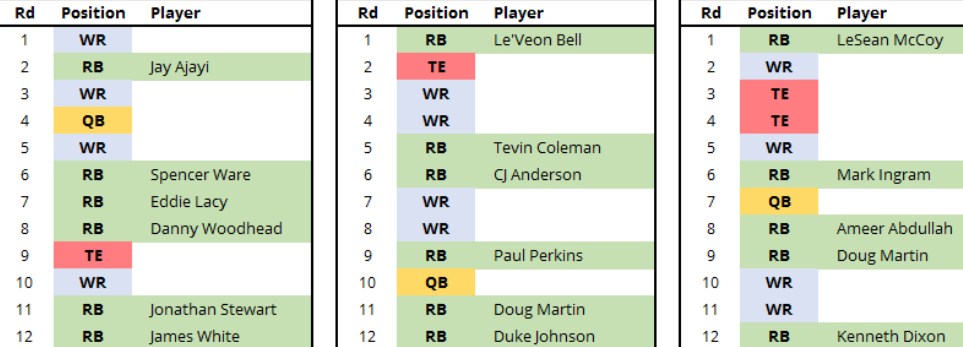NFL Best Ball Theory: Best Ball Modified ZeroRB
A recent hot topic of discussion revolved around the concept of “ZeroRB.” This concept, popularized by Shawn Siegele in his ground-breaking article from 2013, packages theory from Nassim Nicholas Taleb’s book Antifragile into a simple and effective draft strategy.
Today I’m going to lay out a modified version of this concept specifically applicable to NFL Best Ball leagues. Please note the significant differences I discuss below, as I feel they are critical to applying this strategy correctly.
How Does ZeroRB Work?
When Siegele originally penned his piece in 2013, the fantasy football community was awakening to the changing landscape of running backs in NFL offenses. Teams employed specialty backs, and split usage much more evenly between backs. Fantasy players were quickly realizing that three-down running backs were rapidly becoming dinosaurs, but they weren’t necessarily drafting that way. This phenomenon, coinciding with the proliferation of passing game production, created a perfect storm of opportunity in the marketplace. Siegele proposed a clever scheme: “Antifragile” RB, which we’ve come to know lovingly as ZeroRB.
Editor’s Note: Use promo code “GRINDERS” when you sign up for DRAFT and get a free $3 contest entry and THREE months of RotoGrinders DRAFT Premium content!
ZeroRB is simple – don’t draft running backs in high-leverage rounds. For 12-team NFL Best Ball leagues, we will consider the first five rounds as the “high leverage” rounds in our drafts.
The original theory proposes two strategies when applying ZeroRB principles:
• Draft one high-upside running back in Round 4 or 5
• Draft zero running backs in Rounds 1-5
Invoking either of these two strategies means you should spend the high-leverage rounds of your draft selecting wide receivers and elite tight ends. Going into Round 6, your team should have four or five wide receivers, zero or one tight end, and zero or one running back. The roster permutations might look like this:

Now, let’s discuss how we need to modify these principles to account for the lack of waiver wire and trades.
Applying ZeroRB Principles in NFL Best Ball Formats
Should we drop these principles directly into an NFL Best Ball draft and believe it will succeed? Absolutely not. Our inability to hit the waiver wire for suitable replacements dictates that we must modify the original strategy to suit our goal.

I propose that you should draft a consensus “elite” running back in the first two rounds. Then, in Rounds 5-9, draft two to three “Tier 3” running backs with elite production in their range of outcomes. This group of running backs are being drafted at a lower ADP than their production suggests they should be. Finally, in Rounds 11-14, draft another two to three running backs with a clear path to heavy workload, or a defined role as a passing back.
Below, I lay out multiple options for the first twelve rounds of your Best Ball drafts to apply Best Ball Modified ZeroRB principles, but modified for the format. These aren’t specific player targets, but rather examples of how you could potentially draft running backs in adherence with Best Ball Modified ZeroRB.

In total, you should have chosen five to six running backs in the first twelve rounds. In the remaining six rounds, you might draft one to two high-ceiling running backs that could seize a dominant role in the event of injury or ineffectiveness. These might be players such as D’Onta Foreman, Joe Williams, DeAndre Washington, or Darren McFadden.
Please note that you should limit yourself to seven running backs. Going beyond this limit can restrict your depth at other positions (wide receiver, in particular) and leave your roster in a difficult position to withstand the variance of a 16-week league.
Some common roster constructions using Best Ball Modified ZeroRB strategy may include:

Wrapping Up
You might also wish to read up on Mike Beers’s article discussing the concept of Hyperfragile RB. Consider the Hyperfragile RB approach the yin to ZeroRB’s yang. At the time (August 2016) Mike Beers proposed the idea of selecting three consensus Top-15 running backs in the first three rounds of Best Ball drafts. Why? Simply put, market conditions revealed that ADP was heavily depressed for this tier of players, and Beers proposed this idea as a countermeasure.